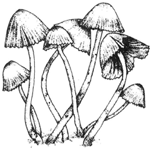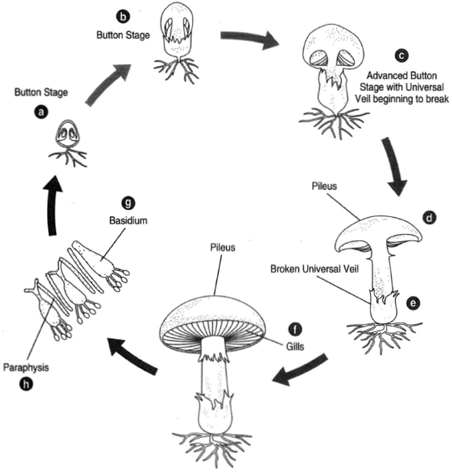Smuts
Ustilago zeae (U. muydis) is an example of a smut. It infects maize, and its life cycle is much simpler than that of rusts. There are no spermatia, no aeciospores, no uredospores, and no alternation of hosts. Corn smut is a costly infection that commonly causes an annual loss of nearly fifty-five million bushels of grain in the United States.Basidiospores invade the floral organs and the adjacent tissues of the corn and produce a mycelium, which is at first mononucleated. Later and as a result of nuclear division without cell division the mycelium becomes binucleated. The mycelium spreads and, in maturity, releases binucleated teliospores. The nuclei of the teliospores then fuse to create a diploid condition. The 2N spores can then germinate, forming a basidium and, by meiosis, four basidiospores. The basidiospores are budded from the sides of the basidium rather than being borne on the tips of sterigmata (as in the rusts).
 |
| Figure 20-8 Coprinus. At maturity, the pileus breaks down into an inky mass. |
A description of a typical basidium was given in the introductory comments of this chapter; but neither the rusts nor the smuts generate the typical form of basidium. Rusts and smuts belong to a subclass called Heterobasidiomycetidae, in which basidia commonly arise from thick-walled resting spores and divide into cells. The subclass Homobasidiomycetidae includes mushrooms, puffballs, and, bracket fungi, which produce clubshaped, nonseptate basidia. Coprinus, a common gill fungus, is representative of this subclass. It has two kinds of spores: plus and minus. A spore resting on an appropriate soil will produce an extensive, monokaryotic mycelium. When this mycelium makes contact with another monokaryotic mycelium of a mating type (for example, a plus mycelium makes contact with a minus mycelium), a union will occur that results in a dikaryotic condition. The plus and minus nuclei are associated in the same cell but are not fused at this time.
The mycelium produces fruiting bodies called mushrooms, or toadstools, entirely composed of compacted hyphae. Figure 20-9 illustrates mushroom development. In the earliest stage, the mushroom takes the form of a button. As the button expands, the covering, called the universal veil, breaks, revealing an elongated stem, the stipe, and, at the tip, the pileus. On the underside of the pileus, gills develop. They are made of compacted parallel hyphae that form a hymenium. The basidia grow out perpendicularly from the hymenium. In the early stages of basidium development, the two nuclei of the dikaryotic cell fuse to create a 2N zygotic nucleus. This nucleus then undergoes meiosis, yielding four haploid basidiospores, which come to lie at the tips of projections (sterigmata). Paraphyses (sterile filaments) also grow out from the hymenium and under microscopic examination can be seen resting among the basidia. Coprinus being a heterothallic form, the union of hyphae take place between mycelia of mating types. Some smut forms are homothallic and thus allow a union of cells from the same mycelium.
 |
| Figure 20-9 Mushroom development. (a) and (b) Button stage. (c) Development further
advanced, with the universal veil beginning to break. (d) The pileus. (e) The universal veil
broken. (f) The gills in the pileus. (g) A basidium, which grows from the surface of the gill. (h) Paraphysis |




